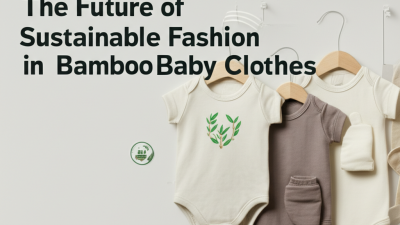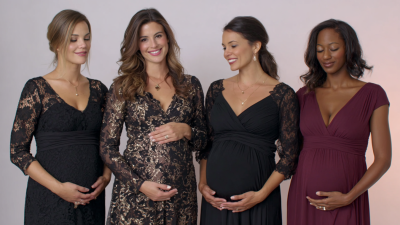The Future of Sustainable Fashion in Bamboo Baby Clothes
Table of Contents
- The Rise of Bamboo in Sustainable Fashion: A Game Changer for Baby Clothes
- Understanding Bamboo Fabric: Benefits for Babies and the Environment
- Stylish and Sustainable: How Bamboo Baby Clothes Combine Fashion and Function
- Tips for Selecting the Best Bamboo Baby Clothing: What to Look For
- Caring for Bamboo Baby Clothes: Best Practices for Longevity and Sustainability
- The Future of Bamboo Fashion: Innovations and Trends to Watch Out For
- FAQS
- Conclusion
- Related Posts
As the sustainable fashion movement gains momentum, Bamboo Baby Clothes have emerged as a frontrunner in the quest for eco-friendly textiles. Reports indicate that the global organic baby clothing market is projected to reach $5.4 billion by 2025, propelled by increasing consumer awareness and demand for non-toxic, environmentally responsible materials. At Sichuan Ecogarments Co., Ltd., we recognize the importance of this trend; established in 2009, our commitment to using natural and organic fibers aligns perfectly with the growing preference for products that are gentle on both babies and the planet. With over a decade of experience in eco-friendly textiles and a reliable organic fabric supply chain, we are poised to lead the way in transforming the landscape of baby apparel, ensuring that sustainability is woven into every piece of clothing for the next generation.

The Rise of Bamboo in Sustainable Fashion: A Game Changer for Baby Clothes
The rise of bamboo in sustainable fashion marks a significant shift in the production of baby clothes. Bamboo is not only one of the fastest-growing plants on the planet but also requires minimal water and no pesticides, making it an eco-friendly alternative to conventional fabrics. According to a report by Smithers Pira, the global market for bamboo textiles is projected to reach $20.6 billion by 2024, as more consumers seek sustainable options for their families. This trend underscores the growing importance of eco-conscious buying behavior among parents who prioritize their children’s health and the environment.
When shopping for bamboo baby clothes, look for certifications such as Oeko-Tex Standard 100, which ensures that the fabric is free from harmful substances. Additionally, consider brands that practice ethical manufacturing and fair labor policies. Not only does bamboo fabric provide a soft and breathable option for your baby's delicate skin, but its natural moisture-wicking properties keep little ones comfortable in any season.
Tip: Always check the care instructions, as some bamboo fabrics may require gentle washing to maintain their softness and longevity. By investing in bamboo baby clothes, you're making a lasting commitment to both your child’s comfort and the planet's future.
Understanding Bamboo Fabric: Benefits for Babies and the Environment
Bamboo fabric is becoming increasingly popular in the realm of sustainable fashion, particularly for baby clothing. This is largely due to its unique properties and environmental benefits. According to a report by the Textile Exchange, bamboo requires significantly less water compared to conventional cotton—approximately 50% less—making it a more sustainable choice. Moreover, bamboo is a fast-growing plant that can grow up to three feet in just one day, helping to mitigate deforestation and combat soil erosion.
The softness of bamboo fabric is another compelling reason for its use in baby clothes. Studies indicate that bamboo is up to 60% more absorbent than cotton, which means it effectively wicks moisture away from a baby's skin, keeping them dry and comfortable. Additionally, bamboo has natural antibacterial properties, which can be beneficial in preventing skin irritations and infections, a concern for the delicate skin of infants. Data from the Global Organic Textile Standard suggests that the use of bamboo can significantly reduce harmful substances in textile processing, further making it a safer choice for babies and the environment alike.
Stylish and Sustainable: How Bamboo Baby Clothes Combine Fashion and Function
As the children’s fashion market evolves, bamboo baby clothes are emerging as a stylish and sustainable choice for eco-conscious parents. With consumer demands shifting towards sustainability, comfort, and innovative materials, bamboo stands out for its soft texture and natural antibacterial properties. Research indicates that sustainable clothing brands can significantly reduce environmental impact; for instance, the fashion industry contributes to approximately 10% of human-caused greenhouse gas emissions. Choosing bamboo baby clothes not only offers a fashionable option but also aligns with a growing movement towards responsible consumption.
**Tips for Choosing Bamboo Baby Clothes:**
1. **Look for Certifications**: Ensure the bamboo clothing is certified organic, adhering to eco-friendly farming practices.
2. **Check for Durability**: Opt for brands known for quality and durability, as this reduces the need for frequent replacements, further minimizing waste.
3. **Style Variety**: Seek out designs that provide both style and function, ensuring your little one looks adorable while enjoying the benefits of comfortable and breathable fabric.
With the global baby apparel market projected to grow significantly in the coming years, incorporating bamboo clothing into your child's wardrobe is a step towards a more sustainable future. Many brands are stepping up their game to provide trendy options that cater to both aesthetic desires and environmental responsibilities.
The Future of Sustainable Fashion in Bamboo Baby Clothes
| Category | Description | Benefits | Environmental Impact |
|---|---|---|---|
| Material | Bamboo fabric is made from the pulp of the bamboo plant. | Soft, breathable, and hypoallergenic for delicate skin. | Sustainable growth, requires less water than cotton. |
| Production Process | Bamboo is harvested and processed into yarn without harmful chemicals. | Eco-friendly production methods, safe for babies. | Minimized pollution and waste compared to conventional textile production. |
| Fashionability | Bamboo baby clothes come in various stylish designs and colors. | Chic and modern aesthetics for both babies and parents. | Promotes sustainable fashion choices among consumers. |
| Care and Maintenance | Easy to wash and maintain, retains shape and softness. | Convenient for busy parents, durable over time. | Long-lasting products reduce the need for frequent replacements. |
Tips for Selecting the Best Bamboo Baby Clothing: What to Look For
When selecting bamboo baby clothing, quality and sustainability should top your list of priorities. Look for garments made from 100% organic bamboo, as this ensures that the fabric is free from harmful chemicals and pesticides. Organic certification is a reliable indicator of the ecological and health standards of the materials used. Additionally, the fabric should have a soft, luxurious feel, which is crucial for a baby's sensitive skin.
Another aspect to consider is the manufacturing process. Brands that prioritize ethical practices often provide transparency about their sourcing and production methods. Opt for companies that embrace fair trade principles and support labor rights. Furthermore, consider the versatility and practicality of the clothing; bamboo fiber offers excellent breathability and moisture-wicking properties, making it an ideal choice for a wide range of weather conditions. Lastly, pay attention to the care instructions, as many bamboo fabrics are machine washable and will retain their softness over time, ensuring that your investment in sustainable fashion pays off in the long run.
Caring for Bamboo Baby Clothes: Best Practices for Longevity and Sustainability
Bamboo baby clothes have gained attention in the sustainable fashion market due to their eco-friendly properties and softness. To ensure longevity and sustainability of these garments, proper care is essential.
Industry reports indicate that bamboo fibers possess natural antibacterial properties, making them not only gentle on a baby's skin but also resistant to odors. Washing bamboo baby clothes in cold water and using a gentle detergent can help maintain their integrity and reduce environmental impact.
According to the EcoTextiles Report, clothes that are cared for properly can last up to 50% longer, significantly lowering their carbon footprint.
When it comes to drying, avoid using a tumble dryer. Instead, opt for air drying to prevent damage to the fibers while promoting sustainability. A 2022 Sustainability in Fashion report found that over 70% of the environmental impact of clothing occurs during the washing and drying processes. Incorporating tips like turning the clothes inside out before washing can minimize fading and pilling, ensuring that your bamboo baby clothes remain vibrant and soft for longer.
Additionally, storing bamboo fabric in a cool, dry place will help preserve its quality. The National Textile Report highlights that proper storage can extend the lifespan of clothing, reducing the need for frequent replacements. Choosing bamboo baby clothes is a step towards a more sustainable future, and caring for them correctly maximizes their benefits for both your child and the planet.
The Future of Bamboo Fashion: Innovations and Trends to Watch Out For
As the sustainable fashion movement gains traction, bamboo baby clothes are emerging as a frontrunner in eco-friendly textiles. The global bamboo clothing market is projected to reach USD 1.5 billion by 2026, according to a recent report by ResearchAndMarkets. This surge is driven by increased consumer awareness around sustainability and the desire for natural, biodegradable materials for their little ones. Bamboo’s rapid growth and low environmental impact make it an ideal choice for parents seeking green alternatives.
Innovations within the bamboo fashion segment are paving the way for exciting trends. For instance, advancements in processing technology are enhancing the softness and durability of bamboo fabrics. A study by Textile World highlights that bamboo textiles possess natural antibacterial properties, making them particularly suitable for baby garments. Furthermore, brands are experimenting with blends of bamboo and other sustainable fibers, leading to versatile and stylish options that do not compromise on comfort or functionality. As this sector evolves, it promises to redefine what sustainable baby clothing can look like, satisfying both ethical and aesthetic demands of modern consumers.
The Future of Sustainable Fashion in Bamboo Baby Clothes
This chart illustrates the growing market for bamboo baby clothes from 2019 to 2023, showcasing a significant increase in value, reflecting the rising demand for sustainable fashion alternatives.
FAQS
: Bamboo requires approximately 50% less water than conventional cotton and is a fast-growing plant that helps mitigate deforestation and combat soil erosion.
Bamboo fabric is exceptionally soft, up to 60% more absorbent than cotton, and has natural antibacterial properties, making it beneficial for a baby's sensitive skin.
The natural antibacterial properties of bamboo help prevent skin irritations and infections, which is particularly important for the delicate skin of infants.
Look for garments made from 100% organic bamboo, as well as consider quality, sustainability, soft feel, and the manufacturer's ethical practices.
Choose clothing that is organic certified to ensure it is free from harmful chemicals and pesticides.
Opt for brands that prioritize ethical practices, support fair trade principles, and provide transparency about their sourcing and production methods.
Many bamboo fabrics are machine washable and retain their softness over time, making them practical for long-term use.
Yes, bamboo fiber provides excellent breathability and moisture-wicking properties, making it suitable for a variety of weather conditions.
The use of bamboo can significantly reduce harmful substances released during textile processing, making it a safer choice for the environment.
Conclusion
The future of sustainable fashion is bright, especially with the rise of bamboo baby clothes. As a game changer in the industry, bamboo fabric offers numerous benefits for both babies and the environment. Its natural properties ensure softness and breathability, providing comfort for delicate skin while being a sustainable choice that helps reduce our ecological footprint.
At Sichuan Ecogarments Co., Ltd., we understand the importance of high-quality materials, and with over 10 years of experience, we prioritize using natural and organic resources in our clothing manufacturing. As the trend for stylish and functional bamboo baby clothes continues to grow, consumers are encouraged to pay attention to key features when selecting the best options. Moreover, caring for these garments properly can enhance their longevity, promoting a sustainable wardrobe for the future. Innovations in bamboo fashion are on the horizon, making it an exciting time for eco-conscious parents and their little ones.
Related Posts
-

Exploring the After Sales Service Benefits and Repair Costs of Best Organic Cotton Baby Clothes
-

Global Reach of China's Finest: Unveiling the Best Bamboo T-Shirt Designs
-

Exploring Global Trends and Success Stories in Best Sexy Panties for Modern Retail Markets
-

Solutions for Finding the Perfect Women Pregnancy Dress for Every Stage
-

The Ultimate Checklist for Choosing the Best Pregnant Gowns Evening Dress
-

Superior Maternity Sweater Crafted in China Setting New Standards in Global Exports

Olivia
-

Contact
-

E-mail
-

Our WhatsApp
-

Top


